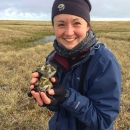Using the Utqiaġvik site as a stepping stone, the Shorebird Section of Migratory Bird Management co-created the Arctic Shorebird Demographics Network (ASDN) with Dr. Stephen Brown of Manomet, Inc. and Dr. Brett Sandercock of Kansas State University in 2010. The ASDN included collaborations by 33 principal investigators and >10 graduate students from 21 institutions across 16 field sites in Alaska, Canada, and Russia. Members of the ASDN have or are collaborating on >20 projects that use the geographically vast and taxonomically rich ASDN data. ASDN studies included investigations of the potential for an ecological mismatch between invertebrate emergence and shorebird hatching, variation in shorebird nest predation across the Arctic, factors affecting shorebird settlement patterns, and adult survival and population models for 6 species of Arctic-breeding shorebirds. Avian health issues investigated included avian influenza, avian malaria, gut microbiota, and mercury exposure. Other studies are or have focused on the effects of spring phenology on timing of breeding in shorebirds, invertebrate phenology in relation to habitat and weather, long-distance dispersal of moss by shorebirds, the distribution of Arctic invertebrates, trends in shorebird population trends, and genetic diversity of shorebirds in relation to population size and other factors. The connections made through the ASDN continue to help form new collaborations.
Monitoring, Research


